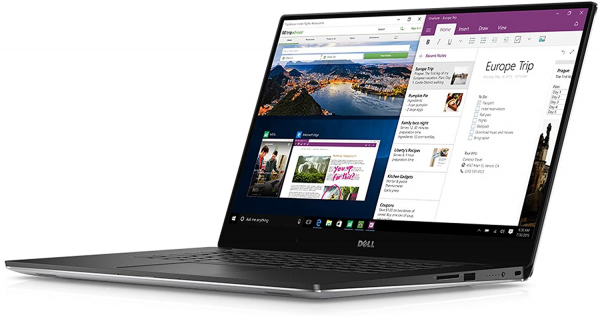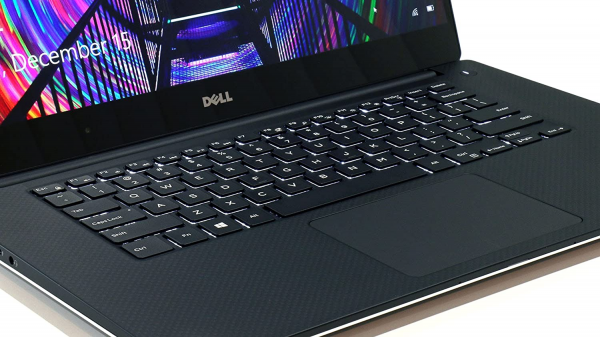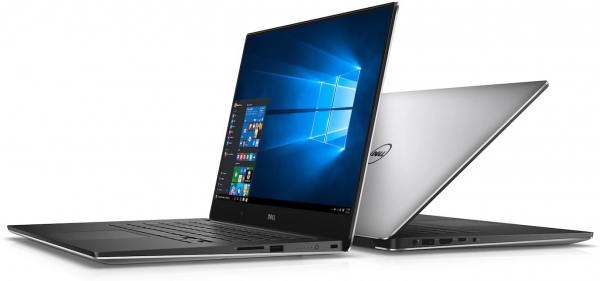Dell
Dell XPS 15: Kaby Lake CPU and Pascal GPU
Aprox. 2370€
See specificationsThe new generation of Dell XPS 15 retains the chassis that had seduced us so much last year, but is boosted by an Intel processor of Kaby Lake generation and a dedicated graphics card GeForce GTX 1050 from Nvidia. Is this new formula always a winner?
Our review
Construction
Note: this Dell XPS 15 version 2017 shares many elements with the model from last year. Consequently, the "construction" part partly reproduces the text of the previous test. Same thing for the "Audio" and "Mobility / Autonomy" parts.
The Dell XPS 15 is an elongated XPS 13: this would be the simplest description of this laptop. We could stop there perfectly, as the two models are similar. Dell has indeed exported the "new" design of the XPS 13 in a 15 inch format, no more no less, which is excellent news. And as on the 13-inch version, we are immediately struck by the finesse of the screen frame (5 mm on the sides and above), now the trademark of the XPS range. This feat of design allows the screen to be widely highlighted and to attract the eye. But it's not just that: the aluminum and carbon fiber chassis is proudly displayed and reinforces the classy side of the product. The construction is very solid, the finish excellent and the tilt angle of the generous hinge (140 degrees).
All around the keyboard, a rubber coating very pleasant to the touch allows the wrists to rest comfortably during typing. We regret, however, the messy side of this material, fingerprints tending to appear very quickly. The keys are well spaced and bounce well, but they could have benefited from a slightly more present return. The backlight, on two levels, is welcome. The touchpad is no frills, but benefits from a good size and a precise glide.
Connection side, the essential is there: two USB 3 ports, a USB Type-C port, an HDMI 1.4 output and an SD card reader. Connectivity is provided by Bluetooth 4.1 and Wi-Fi ac. Note also the presence of a button displaying the battery level.
The temperature and noise are relatively contained, and this despite the presence of a GeForce GTX 1050 graphics card. When used for office or web-based use, a slight breath is heard, but it does not exceed 37 dB and is therefore not at all annoying. In game, however, the fans are much more present and we reach 44 dB. The breath remains diffuse and fairly muffled. In terms of temperature, we noted a hot spot of 51.4 ° C at the front and 48 ° C under the chassis.

Screen
Last year, we awarded 5 stars to the screen of the XPS 13, in its Full HD and matte version. A few months later, an Ultra HD panel, tactile and brilliant, passes through our laboratory ... for a relatively disappointing result.
First of all, it should be noted that several display profiles are available, accessible by right-clicking on the desktop. After several tests, it appears that the "Adobe SRGB" profile is the best in colorimetry, because it displays the lowest Delta E. We indeed reach a dE of 4.3, for a color temperature of 7,180 K. Recall that the Delta E represents the difference between the colors displayed and the actual colors expected and must therefore be as close as possible to 0 It is also considered to be very good below 3. The color temperature is relatively close to the standard of 6,500 K and the rendering is therefore fairly balanced between cold colors and warm colors. This color balance is therefore quite good.
delta color E = 4.3 gamma 2.5 temperature 7180 K
However, the contrast ratio does not exceed 750: 1, for a maximum brightness of 380 cd / m². Very average figures, especially concerning the contrast, which strike a blow to the readability of the whole. Especially since last year's Dell XPS 15 screen had a contrast ratio of 1,160: 1 and a maximum brightness of 390 cd / m². The gamma curve is relatively stable, except at the start of the race, which betrays fairly plugged blacks.
Concretely, the screen of the XPS 15, in brilliant version, UHD and touch, remains good, but does not reach the mastery of its counterpart of last year, and it is frankly a pity. We therefore advise you, as far as possible, to opt for the Full HD and matte version of the product, which is both cheaper and more satisfactory.
The configuration tested:
The configuration received in test includes an Intel Core i7-7700HQ processor, 32 GB of memory, an Nvidia GeForce GTX 1050 graphics card and a 1 TB SSD.

Performances
This test version of the Dell XPS 15 incorporates a 6th generation Intel processor (Kaby Lake), more precisely a Core i7-7700HQ. It is a CPU engraved in 14 nm with 4 cores, which offers frequencies between 2.8 and 3.8 GHz (Turbo). Its TDP is 45 W. The Kaby Lake generation also offers few major differences compared to previous Skylake processors, except for a slight increase in frequency.
In practice, this Dell XPS 15 offers an excellent level of performance and a high power index. The audio and video conversion is particularly fast, as is the photo processing dev.rankuzz.com. It is therefore an extremely versatile PC, which will allow a very wide variety of uses, from the most basic to the most complex.

Games
This is a first for our laboratory, since the Dell XPS 15 is now equipped with an Nvidia GeForce GTX 1050 graphics card (4 GB of video memory). A new graphics card supposed to be placed just below the GTX 1060 and which must offer superior performance to the 960M.
In practice, our 3D Mark performance index shows a fairly small difference with the 960M, but which is widening in game. We thus carried out all our tests in Full HD (1,920 x 1,080 pixels), with all the graphic details maximum (Hairworks has however been disabled on The Witcher 3, as has SSAA anti-aliasing on Metro Last Light and Crysis 3). We note the following results: 53 frames / second on Star Wars Battlefront, 32 fps of The Witcher 3, 34 fps on Rise of the Tomb Raider and 21 fps on Crysis 3. So it's a nice progression compared to the 960M, as you can see in the graph below.
Mobility / Autonomy
Thanks to its very reduced screen margins, the Dell XPS 15 is certainly one of the least bulky 15 inch laptops on the market. Its weight is 1.9 kg, while its thickness reaches 17 mm when closed. It is therefore an easily transportable machine, but of course far from reaching the mobility of a 13 inch format model, like the Dell XPS 13. So plan a fairly large bag, especially since its charger is relatively bulky (435 g, 14.5 x 7 x 2.5 cm).
On the autonomy side, the results are very good for a machine of this size, which is more with a UHD screen. Our reading test under Netflix (Chrome, headphones plugged in, brightness at 200 cd / m²) ran for 5:21. A more versatile use, with office automation and the Web, can be envisaged for almost 7:30, playing with the brightness of the screen and the energy saving. In game, by leaving the Nvidia Battery Boost option activated (which notably limits the number of frames per second to 30), you will however hardly exceed 1h30 of endurance.
Audio
The audio portion of the Dell XPS 15 is average for this type of product. The headphone output produces quality sound, with a low distortion rate (0.01%), good output power (112 mVrms) and a well reproduced sound spectrum.
The speakers (graphics above) deliver a fairly powerful sound, but one that is sorely lacking in bass. The midrange and treble are however quite present.
Conclusion
The Dell XPS 15 2017 edition is again the champion in its class, but not entirely for the same reasons as last year. If the screen loses a little in quality, we clearly gain in power thanks to the Intel Kaby Lake processor couple and GeForce GTX 1050, while the autonomy has been significantly improved. The chassis now heats up a little more and the noise is more present, but nothing annoying enough to remove a star from the final note. A benchmark product, once again.
Specifications

